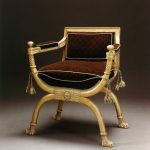9600 A RARE PAIR OF GILTWOOD X-FRAMED ARMCHAIRS PROBABLY BY GEORGES JACOB Paris. Late Eighteenth Or Early Nineteenth Century. Measurements: Height: 33″ ( 84 cm) Width: 27″ ( 68.5 cm) Depth: 21″ ( 53.3 cm)

Research
Of giltwood. Each with molded rectangular framed upholstered back from which issues downswept arms with upholstered armrests ending in a pommel shaped grip. The ‘x’ form front legs and arm supports centered by a stylized lion mask and stiff leaf lotus motifs. Each leg terminating in a well carved zoomorphic foot. Gilding restored.
Provenance:
Daniel Katz collection, London.
David Roche collection, Adelaide, Australia.
The present armchairs are very likely to be by the master menuisier George Jacob (1739-1814), as evidenced by a nearly identical drawing for a chair in the collection of the Musée des Arts Decoratifs, Paris (figure 1), recently identified among anonymous designs.
Jacob’s success is exceptional not only for the quality of his output but because, unlike most ébénistes of the day who were Parisian and born or married into families of cabinetmakers, Jacob was born into a family of peasants in Burgundy. In 1754, at the age of 16, he moved to Paris to begin his apprenticeship and career. He began in the workshop of chairmaker Jean-Baptiste Lerouge and was strongly influenced by the work of Louis Delanois, whom he met during this period. In 1765, he was received master and set up his own shop on rue de Cléry.
Jacob’s inventive style made use of twisted ribbon, guilloche, fluted motifs, and zoomorphic elements that derived from contemporary discoveries. The excavations of Pompeii and Herculaneum, as well as Napoleon’s campaigns in Egypt, turned 18th century designers’ eyes toward antiquity and they began to incorporate archaeological elements into their work. Percier and Fontaine, renowned architects of the time, produced a volume of designs using ancient motifs entitled Récueil de Décorations Intérieures. “These consequently became a favorite model with workers in every conceivable field of applied art…George Jacob being perhaps the ablest of the men making things of this sort.”1 The present chairs are conceived in the same manner as a tabouret illustrated in Récueil (Pl. 39, No. 5), with x-frame seat and legs terminating in zoomorphic feet and centered by a stylized lotus leaf motif (figure 1.) The x-form shape was much favored by the ancient Romans and Greeks for use in seating as well as tables.
Jacob’s reputation grew quickly and spread beyond the borders of France, earning him commissions from the future King George IV of England, Gustavus III of Sweden and various German princes. The successes he enjoyed at home included commissions from French nobles, including the Comte de Provence, the Comte d’Artois and Marie Antoinette. A suite of furniture made by Jacob for the Queen’s dairy at Rambouillet in 1787 comprised x-form armchairs and stools in “the new form of the Etruscan style.”2
Another armchair based on the Etruscan curule chair, illustrated in French Cabinetmakers of the Eighteenth Century, is related in form to the present set (figure 2). Dated to circa 1796, it shares not only the x-form shape, but pommel-shaped grips on the armrests, twisted fluting on the arm supports, and a flat rectangular backrest as well.
At the end of the 18th century the French Revolution was having a detrimental effect on Jacob’s business, as many of his aristocratic clients were exiled or executed without paying their debts. In fact, Jacob himself was faced with imprisonment, but a beneficial friendship with the painter Jacques-Louis David prevented his arrest. David, for whom Jacob also created furniture, not only intervened on behalf of the ébéniste, but secured him commissions from the revolutionary government and the Emperor Napoleon.
Jacob handed over the business to his sons, Georges and François-Honoré, and retired in 1796. However, in 1803 he returned, following George’s death, and the pair worked under the protection of the Emperor until Jacob died in 1814.
The present chairs were formerly in the collection of David Roche (1930-2013), renowned Australian connoisseur and art and antiques collector. Roche’s appreciation for art and design began as a child with frequent trips to Europe to tour the great museums, and he started collecting as a teenager. He continued to expand and refine his collection over the years until it became the greatest assembly of English Regency and French Empire furniture, paintings, and objets d’art outside of England. Many of the works possess an impressive provenance including Napoleon Bonaparte and Empress Josephine. In 1999 he established the David Roche Foundation to maintain and preserve the collection, contained in Fermoy House (Mr. Roche’s home in Adelaide), which he bequeathed to the people of Australia and which will be open to the public.
Footnotes:
1. Murdoch, W.G. Blaikie. “The Applied Arts in France: XIIIth Century Furniture.” Arts and Decoration November XII.2 (1916): 201-04. 204
2. Frégnac, Claude, and Jean Meuvret. French Cabinetmakers of the Eighteenth Century. Paris: Hachette, 1965. 239.




Comments are closed.